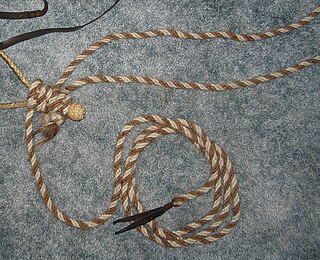 W
WA bit converter, also known as a pelham rounding, is used on pelham bits to change them from two-rein bits to one-rein bits. It is a leather strap that attaches from the snaffle ring to the curb ring, onto which the rein is then attached to the loop made between the two rings. A bit converter is very helpful when riding the cross-country phase of eventing, so that a rider using a pelham does not have to keep track of two reins— especially helpful when riding drop fences, which require the rider to slip the reins and then gather them back up on landing. It is also commonly used by children, who may have not yet become skilled enough to handle two reins with ease. However, the bit converter diminishes the rider's ability to apply the curb and snaffle functions of the pelham independently and discriminately, and thus is usually considered unsuitable for other types of riding; it is illegal in hunt seat equitation, for example.
Draw reins and running reins are pieces of riding equipment used for training that use the mechanical advantage of a 'single movable pulley' to cause the horse to bring its head down and inward. While a regular rein is the strap that attaches to the bit and is held by the rider, these types of reins slide through the bit ring, adding leverage to the rider's hands and arms, allowing the rider to force the horse's head into a desired position.
 W
WThe mecate is the rein system of the bosal style hackamore used to train young horses. It is a long rope, traditionally of horsehair, approximately 20–25 feet long and up to about 3/4 inch in diameter. It is tied to the bosal in a specialized manner that adjusts the fit of the bosal around the muzzle of the horse, and creates both a looped rein and a long free end that can be used for a number of purposes. When a rider is mounted, the free end is coiled and attached to the saddle. When the rider dismounts, the lead rein is not used to tie the horse to a solid object, but rather is used as a lead rope and a form of Longe line when needed.
 W
WA bearing rein, known today as an overcheck or a checkrein, is a piece of horse tack that runs from a point on the horse's back, over the head, to a bit. It is used to prevent the horse from lowering its head beyond a fixed point. A variation called a side check passes beside the ears through loops at the top of the bridle cheekpieces.
 W
WReins are items of horse tack, used to direct a horse or other animal used for riding. They are long straps that can be made of leather, nylon, metal, or other materials, and attach to a bridle via either its bit or its noseband.
 W
WA Romal, is a type of long quirt attached to the end of a set of closed reins that are connected to the bridle of a horse. It is not to be used to strike a horse, but rather was a tool used to assist in moving cattle.
 W
WSide reins are equipment used when longeing a horse, running from the bit of the bridle to the saddle or surcingle. As a horse training tool, they encourage flexion and softness in the horse's mouth. For longe line work with a rider up who does not carry ordinary riding reins, they help calm and settle the animal. However, they are a tool best used by experienced handlers; used improperly they may unduly restrict the horse's movement or cause an accident.